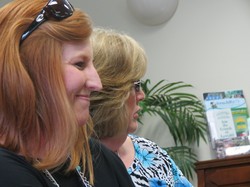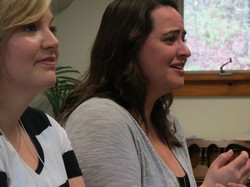Layers of beauty are in the air. The kind you expect, and the kind you don’t—which runs deep, taking your breath away.
At the Presbyterian Ferncliff Camp and Conference Center both are present.
“It’s funny how we prefer to stay in our horrible, dark caves,” says Christine Dove. “I was sick, mentally unstable for a long time. And yet the gift still comes.”
Dove, a survivor of the Columbine High School shootings in 1999, is talking about the gift of healing she found at Ferncliff, given to her by survivors of a school shooting in Arkansas. They were younger, but like her they carried wounds.
Ferncliff hosted the Responding to School Violence conference for national camp leaders April 7-9, in partnership with Presbyterian Disaster Assistance.
They came to hear from survivors of school shootings. They also heard from those who initially helped them navigate their mountains of grief at “healing camps” held at Ferncliff from 1998-2002
The goal of the conference was to prepare camp leaders to actively respond—and to become part of a network PDA can turn to—should an unspeakable act of school gun violence happen in their part of the country.
‘We’ve got to do something’
In March of 1998, two boys with guns—ages 11 and 13—opened fire at Westside Middle School in Jonesboro, Ark., killing four students, and a teacher. Ten other children were wounded.
One hundred and fifty miles south of Jonesboro, pastor David Gill was in his second year as Camp Director at Ferncliff.
“I woke a few mornings after the shooting and told my wife, 'We’ve got to something,'" says Gill.
Gill had received “a knowing” of sorts since the shooting happened. This is where he was supposed to be. To create vision and change, to move Ferncliff beyond “taking care of our own.”
Gill knew theWestside kids would need a safe place with trustworthy, caring adults. He began sharing a vision that involved forming a diverse coalition of pastors and mental health professionals, meeting with parents, teachers and administrators of Westside, and earning the trust of families—and the community—in Jonesboro.
In July, exactly four months after the shootings, 68 kids from Westside showed up for healing camp.

Brandi Crane, 11 at time of shooting, with mom Brenda George, who is grateful that Ferncliff “gave me my daughter back.” —Paul Seebeck
Saving lives through ‘a triage of tears’
As 11 year old, Brandi Crane remembers she “wanted to kill herself” the week before coming to Ferncliff.
“They saved our lives,” she says. “They’re part of the reason many of are still alive today.”
“They gave me my daughter back,” adds mom Brenda George. “She was more herself after that week.”
On the Tuesday night of the first healing camp, participants gathered under the sky in an open field.
The setting, seen through survivors' eyes as unprotected, and certain words used in the session triggered feelings that had been buried: Running from school. Bullets flying. Stepping over bodies. Where is my best friend? Wasn’t she locked on my arm as we ran?
Gill recalls girls crying so hard they got dehydrated. The triage of tears lasted well past midnight. In the morning, as the sun came up, he remembers that the girls were beaming.
“That’s because they didn’t talk to us like we needed to be fixed,” says Jessica Odom, who was 13 at the time of the shooting.
They just held us, and kept saying things like, ‘you are in pain, I am here for you.’”
Healing camp therapist Linda Van Blairicom noticed something else. The boys were withdrawing. Distancing themselves from the tears.
The next night the boys went to their male counselors, wanting to do something mischievous for the girls.
The counselors listened then suggested the boys sing to the girls.
“It was one most beautiful nights of my life,” says Van Blairicom. “Those young boys began singing, eventually kneeling down—and than their breakthrough occurred.”
Van Blairicom indicates it was a catharsis of sort for the boys—who had been carrying guilt for not protecting the girls on that awful day.

Erica Lafferty and Richard Martinez — each ringed bracelet on his wrist bear the name of a child killed in school shootings. —Brian Frick
Everytown for Gun Safety advocates speak
Richard Martinez and Erica Lafferty attended the Ferncliff conference as advocates for reducing gun violence in America.
Martinez lost his son, Chris, who was murdered the in the UC Santa Barbara campus shooting last year. Lafferty’s mother, Dawn Lafferty Hochsprung, was the principle killed at Sandy Hook Elementary School.
They told participants that since the fatal shooting at Sandy Hook where 26 were killed, there have been 111 school shootings.
“Are we the most civilized country in the world going to accept as normal shooting drills in our schools?” asks Martinez.
"We’re teaching our children to hide from murders,” cries out Dove.
For a moment, only the silence of these statements is heard.
“Listen, there are a variety of solutions,” says Martinez. “It’s like with traffic deaths. Over time we changed it. Seat belt laws were a part of that.”
“Which is why our focus is on background checks,” says Lafferty.
My passion now is for life—and making sure others don’t have to feel pain, like I feel every single day,” she says.
Camps are healing
After the first healing camp, Ferncliff decided to hold an annual camp for the Jonesboro kids until they graduated from high school. When Columbine happened, the Jonesboro students came to Ferncliff staff asking if they could invite survivors in Colorado to “their camp.”
As healing camp grew to include survivors of shootings from Paducah, Bosnia, Los Angeles, and New York City after 9/11, Gill received another “knowing.”
He explains that the elements of camp—nature, art, recreation, small group Bible study and connection, community 24/7, and mentoring by college-aged students—are in and of themselves healing.
“These things of camp make us healthy,” he says.
“Healing camp all started with us wanting those Jonesboro kids to be able to be kids again—to have fun—in a safe place, around trustworthy adults," says Gill.
It is one of the best things we’ve ever done. Seeing the ripple effect for so many years feels good. It will be a lasting legacy of this place."

